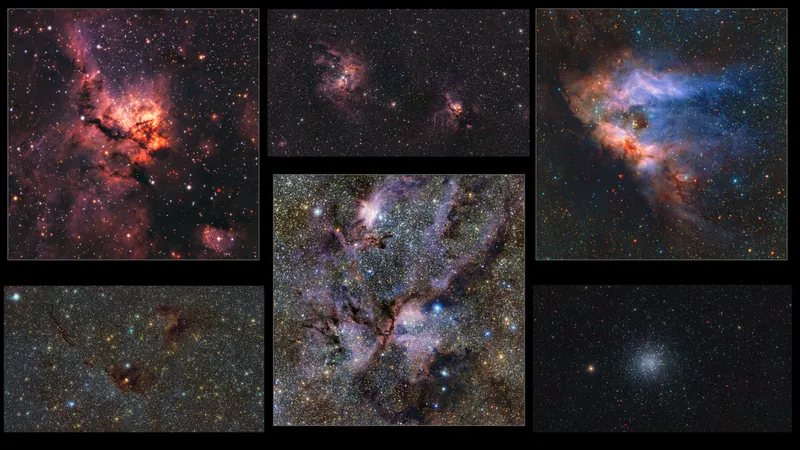
Unveiling the Milky Way: A Groundbreaking Map of 1.5 Billion Celestial Objects Transforms Our Understanding of the Galaxy
2024-09-27
Overview of the Milky Way Map
In a remarkable achievement for astrophysics, a newly released infrared map of the Milky Way showcases an astonishing collection of over 1.5 billion celestial objects. This groundbreaking project, spearheaded by the Visible and Infrared Survey Telescope for Astronomy (VISTA) at Chile's Paranal Observatory, represents the most detailed view of our galaxy ever created.
Over a span of 13 years, from 2010 to 2023, VISTA captured 200,000 images as part of the VISTA Variables in the Vía Láctea (VVV) survey and its extension, the VVV Extended Survey (VVVX). The combined effort has resulted in a stunning visual representation of an area of the sky equivalent to 8,600 full moons visible from Earth. Disturbingly, this new catalog contains ten times more objects than the previous map released in 2012, reflecting the remarkable advancements in observational technology and data processing.
Dante Minniti, a leading astrophysicist at the Universidad Andrés Bello and project head, expressed his excitement: “We made so many discoveries we have changed the view of our galaxy forever.” This sentiment encapsulates the profound implications this map has for our understanding of the Milky Way.
The Role of VIRCAM
The innovative VIRCAM (Visible and Infrared Camera) on the VISTA telescope played a crucial role in this achievement. Its capabilities enabled astronomers to look beyond the gas and dust that typically obscure celestial objects, revealing hidden features of our galaxy and painting a more comprehensive portrait of our cosmic neighborhood.
What Wonders Await in The VISTA Milky Way Map?
The newly created Milky Way map offers a panorama of celestial objects, including stellar nurseries bustling with newly formed stars enveloped in gas and dust. Notable among these is NGC 6357, also known as the "Lobster Nebula," situated approximately 5,900 light-years from Earth in the constellation Scorpius. This nebula serves as an excellent example of where star formation is actively taking place.
Another significant region captured in this survey is the Omega Nebula (Messier 17), located around 6,000 light-years away within the constellation Sagittarius. This visually stunning cloud of star-forming gas stretches 15 light-years wide and is part of a much more extensive molecular cloud measuring about 40 light-years across.
The VISTA observations also highlight NGC 3603 and NGC 3576, the latter being known as the "Statue of Liberty Nebula." NGC 3603, at approximately 20,000 light-years distant, is recognized as one of our galaxy's most massive young star clusters, while NGC 3576 is much closer, about 9,000 light-years away, and teeming with brilliant young stars.
While young stars dominate certain sections of the map, older stars also come into focus. Many inhabit globular clusters—dense collections of ancient stars that formed from the same primordial materials. For instance, Messier 22 (NGC 6656), which lies around 10,000 light-years from Earth, is among a select group of globular clusters containing at least two stellar-mass black holes and six rogue planets that do not orbit any primary stars.
Additional intrigue surrounds Messier 22 as it hosts one of only four known planetary nebulae found within globular clusters. Despite the term “planetary,” these nebulae originate from the remnants of massive stars that have undergone dramatic supernova events.
A New Perspective on the Milky Way
VISTA's commitment to revisiting the same portions of the sky over 420 nights has offered astronomers new insights into the dynamics and variability of celestial objects. This meticulous approach has allowed scientists to construct a more sophisticated three-dimensional map of the Milky Way, unveiling the hidden complexities of our galactic home.
Roberto Saito, an astrophysicist at Universidade Federal de Santa Catarina and team leader, commended the collaboration essential to this project, stating, "The project was a monumental effort, made possible because a great team surrounded us." Indeed, the results of this extraordinary collaboration promise not only to deepen our knowledge of the Milky Way but to inspire future explorations that could further redefine our place in the universe.
Conclusion
This monumental map is not just a scientific advancement; it represents a fascinating leap forward in our quest to understand the cosmos and our role within it. Stay tuned for more updates as scientists continue to analyze the vast data set and make new discoveries!









 Brasil (PT)
Brasil (PT)
 Canada (EN)
Canada (EN)
 Chile (ES)
Chile (ES)
 España (ES)
España (ES)
 France (FR)
France (FR)
 Hong Kong (EN)
Hong Kong (EN)
 Italia (IT)
Italia (IT)
 日本 (JA)
日本 (JA)
 Magyarország (HU)
Magyarország (HU)
 Norge (NO)
Norge (NO)
 Polska (PL)
Polska (PL)
 Schweiz (DE)
Schweiz (DE)
 Singapore (EN)
Singapore (EN)
 Sverige (SV)
Sverige (SV)
 Suomi (FI)
Suomi (FI)
 Türkiye (TR)
Türkiye (TR)